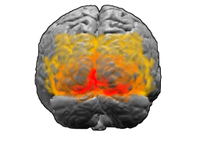
Photo from wikipedia
OBJECTIVE The goal of this work is to develop and characterize an innovative experimental framework to design interconnected (i.e., modular) heterogeneous (cortical-hippocampal) neuronal cultures with a three-dimensional (3D) connectivity and… Click to show full abstract
OBJECTIVE The goal of this work is to develop and characterize an innovative experimental framework to design interconnected (i.e., modular) heterogeneous (cortical-hippocampal) neuronal cultures with a three-dimensional (3D) connectivity and to record their electrophysiological activity using Micro-Electrode Arrays (MEAs). APPROACH A two-compartment polymeric mask for the segregation of different neuronal populations (cortex and hippocampus) was coupled to the MEA surface. Glass microbeads were used as a scaffold to mimic the 3D brain micro-architecture. MAIN RESULTS We built a fully functional heterogeneous 3D neuronal network. From an electrophysiological point of view, we found that the heterogeneity induces a global increase of the activity rate, while the 3D connectivity modulates the duration and the organization of the bursting activity. SIGNIFICANCE In vivo, studies of network dynamics and interactions between neuronal populations are often time-consuming, low-throughput, complex, and suffer from reproducibility. On the other hand, most of the commonly used in vitro brain models are too simplified and thus far from the in vivo situation. The achieved results demonstrate the feasibility to build a more realistic and controllable experimental in vitro model of interconnected brain regions on-a-chip whose applications may have impacts on the study of neurological disorders that impair the connectivity between brain areas (e.g., Parkinson disease).
Journal Title: Journal of neural engineering
Year Published: 2020
Link to full text (if available)
Share on Social Media: Sign Up to like & get
recommendations!